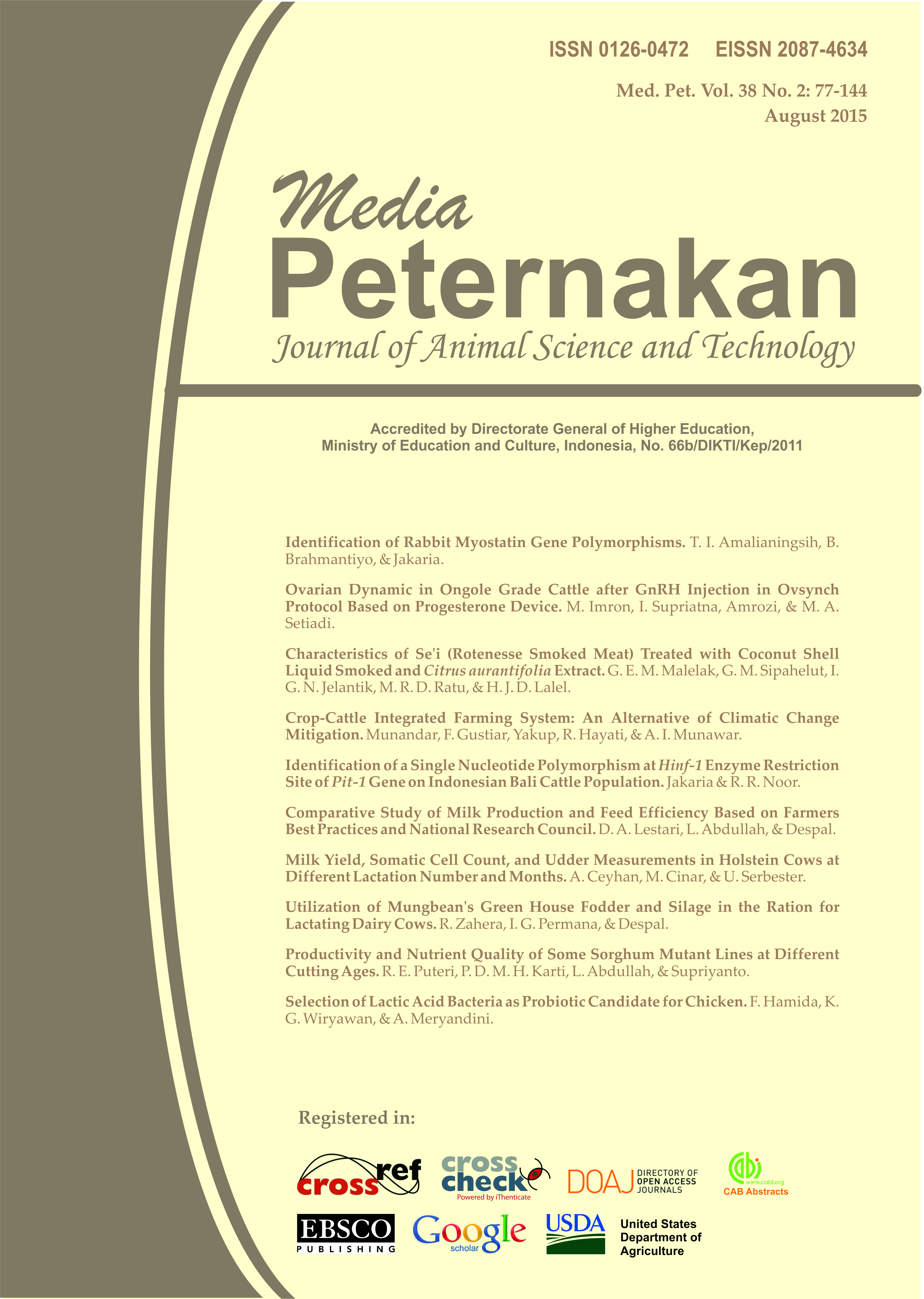Crop-Cattle Integrated Farming System: An Alternative of Climatic Change Mitigation
DOI:
https://doi.org/10.5398/medpet.2015.38.2.95Abstract
An integrated farming system is one of the alternatives for climatic change mitigation. This paper reports the application of corn-cattle based integrated farming system in Agrotechno Park Center of Palembang, and discusses its impact on CO2 fixation and the reduction of methane emissions. The study was based on the data of the first 6 yr from 2003 until 2009. The CO2 fixed in the soil and plants was determined based on the content of organic C which was multiplied by the index of 3.67. The methane gas produced by Balinese cattle and its dung was observed and modified into feed rations. The results showed that soil organic C increased from 40.80 tons C/ha in the 1st yr to 66.40 tons C/ha in the 6th yr. In addition, there was organic C fixation equivalent to 93.95 tons of CO2e. Corn biomass increased from 6.67 tons/ha to 18.66 tons/ha, equivalent to an increase in the fixation of atmospheric CO2e as much as 19.80 tons CO2e/ha. The supplementation of 60%-80% grass fodder with concentrate lowered the concentration of methane gas in cattle breathing by 28.7%, from 617 ppm to 440 ppm, while the methane emissions from cattle manure decreased by 31%, from 1367 mL/head/d to 943 mL/head/d. Installing a bio digester that generates biogas served to accommodate methane gas emissions from cattle dung and used it for bioenergy. Composting reduced the formation of methane gas from cattle manure through a regular process of turning over that gives aeration and forms aerobic condition in the heap of cattle dung. Recycling produces a variety of organic products that store carbon for a longer period of time and slowed the conversion of organic C into CO2. This study showed that the diverse activities of an integrated crop-cattle farming could be an alternative solution to climatic change mitigation.
Key words: integrated farming, mitigation, organic C, methane, recyclingDownloads
References
Adam,R.M., B.R.Hurd, S.Lenhart,and N.Leary. 1998. Effect of global climate change on agriculture: an interpretative review. Climate Research, Vol.11:19-30.
Atmojo, Suntoro Wongso. 2007. Pertanian Organik, Integrasi Ternak dan Tanaman. Makalah Harian Solo Pos 7 Maret 2007
Ching. Li Lim. 2011. Mitigating and Adaptation to Climate Change through Ecological Agriculture. Environmental & Development Series 11. TWN Third Word Network Penang Malaysia.
Erwanto, Farida Fathul, Yusuf Widodo, Mucharomah Prayudiwati. 2008.Kegiatan Pendampingan Integrasi Usahatani Jagung-Usaha Ternak: Pengenalan Teknologi Pengolahan Pakan Ternak di Desa Bandar Agung, Kecamatan Bandar Sribhawono Kabupaten Lampung Timur. Laporan Pengabdian Masyarakat, LPPM. Universitas Lampung.
Franzluebbers . Alan J. 2005. Carbon Sequestration and Land Degradation. Soil Tillage Res. 83:120-147
Kusler,J. 2006.Common Questions: Wetland,Climate Change, and Carbon Sequestering. Association of State Wetland Manager,Inc. In Cooperation with The International Institute for Wetland Science and Public Policy.
Mae-Won Ho. 2006. How to beat climate Change and be food ang energy Rich- Dream Farm 2. Word Magazine. May-June 2006. Vol. 19 No 3. Institute in Science on Society.
McConkey.B. B.C.Liang. G.Padbury and W.Lindwall. et al. (2005).Carbon Sequestration eand dirrect seeding. Semiarid Prairie Agriculural Research Center. Agriculture and Agrifood Canada.
Marschner, H. 1995. Mineral Nutrition of Higher Plants. Academic Press Inc., London.
Munandar. 2014. Pertanian Terpadu BioCyloFarming. Balai Agro Teknologi Terpadu Palembang. Kementerian Riset dan Taknologi, Paparan Press Tour dan Gathering Wartawan IPTEK. Kementerian Riset dan Taknologi, Jakarta.
Muslim, Chaerul. 2006. Pengembangan Sistem Integrasi Padi Ternak Dalam Upaya Pencapaian Swasembada Daging di Indonesia: Suatu Tinjuan Evaluasi. Analisis Kebijakan Pertanian, Volume 4 Nomor 3. 226-239.
Nigli. U.FlieBbach.A..Hepperly.P. and Scialabba.N.2009. Low Green Agriculture: Mitigation and Adaptation Potential of Sustaiable Farming Systems. FAO. April 2009.Rev. 2-2009.
Smith.P.Martino. D.Cai.Z.Gwary. D.Janzen. H.Kumar. P.McCarl. D.Ogle. S.OMara. F.Rice. C.Scoles. B.O.Sitotenko. 2007. Agriculture. in Metz. B.Davidson. O.R.Bosch.P.R. Dave. R and Meyer.LA. (eds).Climate Change 2007. Mitigation. Contribution of Working Group III to Fourth Assesment Report of the Intergovermental Panel on Climate Change. Cambridge University Press. Cambridge.UK and New York NY USA.
Smith.. P and J.E.Olesen. 2010. Climate Change and Agriculture: Synergies between the mitigation of. and adaptation to. climate change in Agriculture. The Journal of Agricultural Science. Online publication June 07 2010.
Sudjana. Tjeppy D. 2004. Sistem Usahatani Terintegrasi Tanaman Ternak sebagai Respon Petani Terhadap F Kementerian Riset dan Taknologi,actor Risiko. Jurnal Litbang Pertanian. 26(2):82-87.
Sundermejer. I. R Reeder and R. Lal 2004. Carbon management and Sequestration. Science. 11(1623-1627).
Syafruddin, Saidah dan F.F.Munir. 2006. Integrasi Tanaman Jagung dengan Ternak Sapi psda Lahan Kering Melalui Sistem Pertanaman Padat, di Lembah Palu, Sulawesi Tengah. Prosiding Seminar Nasional Pengembangan Inovasi Pertanian Lahan Marginal. Hal. 211-216.



